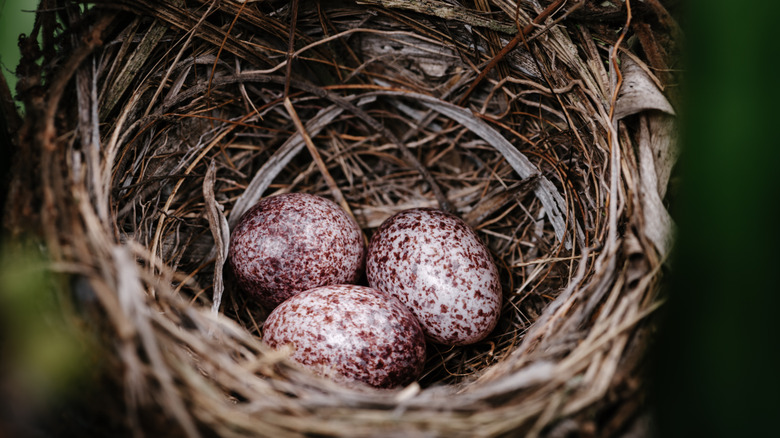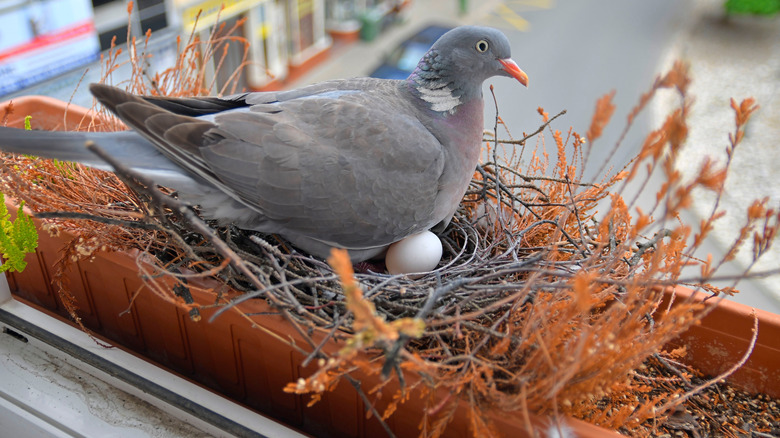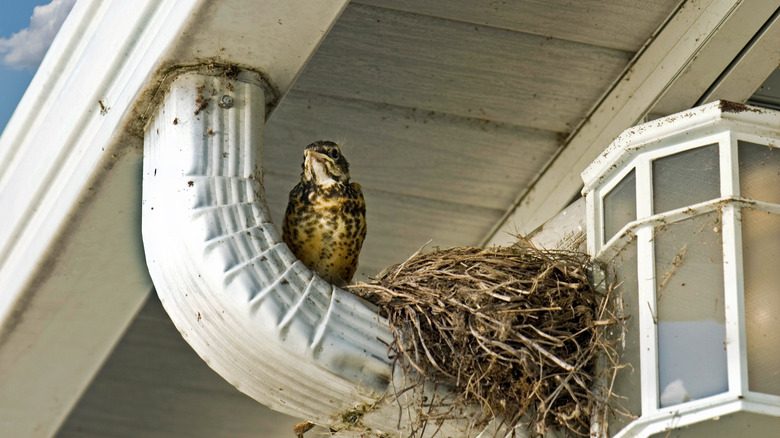Here's When It's Okay To Remove A Bird's Nest (& Avoid Hurting Any Birds)
No matter how many birdhouses you hang around your yard, birds will make a nest anywhere they feel safe. In your trees or bushes? Naturally. Under the eaves of your roof? Sure, because it stays nice and dry. In the garage? To our avian friends, it's practically a palace. Although it can be a nice surprise to stumble across one out in the wilderness, you might find yourself motivated to move a bird's nest if it's too close to your home. According to Charles van Rees, Ph.D., conservation scientist, naturalist, and owner of Gulo in Nature, a resource for everyday people with nature questions, it's typically not legal to remove a bird's nest unless there are no eggs or young inside it.
During his exclusive interview with House Digest, van Rees explained that it's very important to understand the laws, regulations, and protections around migratory birds before learning how and when to move a bird's nest. "All native wild birds in the U.S., and their eggs, are protected by the Migratory Bird Treaty Act, and moving or handling them is illegal without permits," he explained. The expert said there are some non-native invasive species, like European starlings, that aren't protected. Nests that don't have eggs in them are also not illegal to move. But as soon as an egg is laid in a nest, van Rees cautioned that it is protected by law. "Importantly, there is not much difference between moving and removing a nest," he added. "Handling and tampering with a nest, especially moving it to a new location, will likely make parents abandon the nest."
Moving a bird's nest usually causes irreparable harm to the occupants
There are a lot of ways to attract birds to your garden, and watching them flit around your feeders is one of life's little pleasures. But sometimes your feathered friends will decide they like what you've done with the place so much that they start to make nests. They'll frequently use nearby leaves and grass, bark and moss, and they may even try to incorporate fur from your pets when they can find it. From your front door wreath to your woodpile, these nests can quickly become a real headache that's difficult to handle without running afoul of the law or causing harm to the flock.
"In most cases, it is not really possible to move a bird's nest without harming its occupants," Charles van Rees told House Digest during his exclusive interview. "If there are eggs or young in the nest, the parents may be unlikely to return to the nest if it is moved," he explained, adding that any new location you select may put them at greater risk of predators. "Many bird nests are built carefully into or onto whatever structure that they were constructed on, and moving them often compromises the nest and makes it weak and flimsy." Because of this, van Rees said it is difficult for birds to make structural repairs to their nests after they are moved. "Long story short, moving any nest is likely dooming its occupants."
Remove nesting opportunities to limit future nests on your property
So, what should you do if you find a nest on your property and want to remove it? According to Charles van Rees, the first step is checking to see if it contains eggs or young. If so, you'll need to wait until they have fledged. "The good news is that this may only take a few weeks," the expert said during his exclusive interview with House Digest. "Once all the young have left the nest, it can be legally removed."
From installing screens over your eaves to offering alternative nesting sites, there are some clever ways to prevent birds from nesting around your house, though you may be surprised at how persistent they are once they find a nesting spot that is safe from predators and harsh weather. "It's not easy to discourage birds from nesting in places they might find attractive," van Rees explained. He suggested that reducing nesting opportunities is the best way to minimize the likelihood of finding more nests around your property, such as by "eliminating sheltered or shaded, small, and isolated surfaces that would be safe from land-based predators like cats but which provide shade and refuge from the rain." But even this may not keep your landscaping entirely nest-free. According to van Rees, "Any cozy nooks and crannies will be fair game for many common house-nesting birds!"


